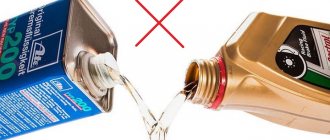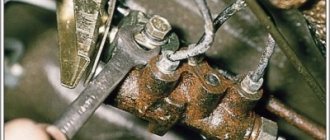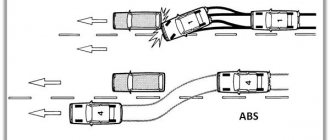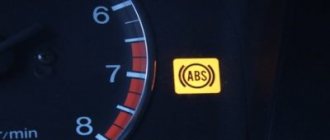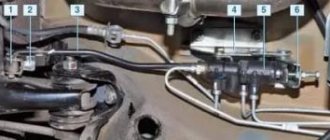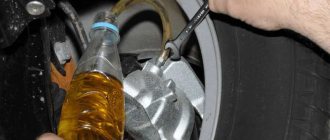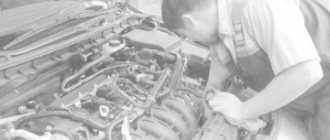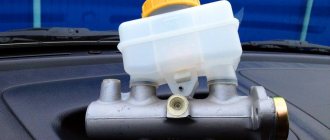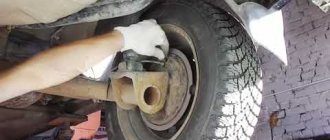In order for the brake system in a Lada Priora to function correctly, it must contain the working fluid at the proper level. What volume is required for the correct functioning of the brake system can be found in the service book attached to the machine.
If the volume of brake fluid is insufficient, this will be signaled by a specially created device and a button located in the cabin on the control panel. As soon as the red icon lights up, which shows the bends, you need to immediately add liquid.
At the same time, you should inspect the entire system responsible for the brakes, since if the brake fluid leaks, this may indicate problems or the need to replace the master cylinder gasket.
Anti-lock braking system ABS: types, types
Depending on the type and type, ABS is classified into:
- One scheme of operation of the ABS system is when all the devices that make up the ABS are located in one unit. That is, the hydraulic valve block, hydraulic accumulator and pump are located in one unit.
- The second ABS scheme is when the component devices (hydraulic valve block, hydraulic accumulator and pump) are located in different places. In this type of braking system, in addition to the ABS module, there is also an ESP module and an SBC module.
Whether you can bleed the brake system yourself depends on what type of brake system is in your car.
If the car has a system of the first type, then it is easy to properly pump the ABS.
If the car has a system of the second type, then one cannot cope without a scanner; it needs to be pumped to a service center for maintenance.
The ABS system consists of:
- Sensors (installed on the hubs). When replacing rear wheel hubs, as well as some front ones, you may notice special recesses for sensors. They are engaged in transmitting data about the speed of movement.
- Control valves (installed in the brake system). Serve to change the pressure in the system.
- The electronic unit. Receives speed information from sensors and adjusts control valves.
Summary
You can replace the fluid yourself only on cars with a hydraulic accumulator and valves combined into one unit. List of required equipment:
- syringe with extension tube or bulb;
- transparent containers;
- transparent tube 20-30 cm long;
- open-end wrenches at “8” or “10”.
Briefly about the procedure for replacing brake fluid in a car with ABS on your own:
- replace the composition in the tank with a new one;
- bleed the left and right front brake cylinders;
- bleed the rear right cylinder with the brake pedal depressed and the pump turned on;
- bleed the rear left cylinder with the brake pedal released and the hydraulic pump turned on;
- check the system for leaks.
If there is a drain fitting on the ABS module, you should use the classical method according to the scheme specified by the factory to bleed all 4 brake cylinders, and then “drive” the ABS installation with excess pressure supplied from outside.
How to determine malfunctions of the Lada Samara 2113 thermostat and replace it yourself
Many who spend most of their time on the road might have seen a car standing on the side of the road with clouds of steam escaping from under the hood. At the same time, even ordinary people who are far from the design of engines understand that this indicates problems in the cooling system, and more “advanced” ones will also point out
Learning to repair Lada Priora: dismantling and installing the main brake cylinder
In the current Lada Priora model, AvtoVAZ engineers were able to eliminate some errors that occurred in the tenth series.
Signs and causes of brake disc failure. The procedure for restoring their functionality
Brake discs in Toyota cars play an extremely important role. The safety of driving a car depends on them. During operation, the working surface of these elements gradually deforms, which leads to an increase in the likelihood of an emergency situation occurring on the road.
Technology for repairing elements of the brake system of a VAZ 2110 car. Main and working brake cylinders
The main elements of the brake system of a modern car. Hydraulic drive is the main type of design used to install a service brake system
Perfect brake condition guarantees car safety
Brake pads are among the parts most susceptible to wear. Since they, along with other components of the brake system, are responsible for the safety of the car, it is necessary to pay attention to any signs indicating their wear in order to promptly replace the brake pads on the VAZ
ABS bleeding sequence
- First, we look for and remove the fuse in the fuse block that is responsible for the operation of the anti-lock braking system.
- Next, we jack up and remove one front wheel, and look for the brake wheel cylinder (BWC) fitting.
- After this, we put a hose on the fitting (from a hydraulic level, for example).
- Open the fitting one turn.
- One presses the brake pedal all the way and holds it in that position.
- Now turn the ignition key to turn on the hydraulic pump (the ABS indicator lights up on the instrument panel).
- The second person watches how air is removed through the hose and, after removing the air, tightens the fitting.
- We release the brake pedal only after tightening the fitting.
- Now, how do you know that all the air has escaped from the ABS? This shows the ABS icon on the dashboard, if it goes out after removing the air and tightening the fitting, then all the air has escaped.
Reasons for replacement
AvtoVAZ recommends changing the front pads every 30-50 thousand kilometers. But you don’t always need to strive for the indicated numbers, since different cars are used in different modes.
There are drivers who constantly use the car on the highway, and there are also those who only drive around the city. When in city traffic jams you have to brake more often.
Regardless of operating conditions, it is important to inspect the pads monthly. If they wear too much, the brake disc is damaged. And this puts the driver of the vehicle at risk.
Parameters under which the pads need to be changed:
- overlay thickness less than 1.5 millimeters;
- the lining is unevenly worn or does not contact the brake disc tightly;
- the pressure spring is faulty;
- The lining is damaged, there are cuts and deformations.
Depending on the manufacturer, the cost of the pads varies from 500 to 2000 rubles.
Conclusion
After carrying out repair and maintenance work on critical components of the car, before driving, you must first check the tightness of the system and the operability of the vehicle components.
ABS - Anti-lock Braking System is a system against wheel locking during heavy braking. Thanks to the fact that ABS prevents the car from skidding along the road, safety increases in emergency situations. The anti-lock braking system will operate correctly if the system is not air-filled.
Watch this helpful video. Tests show that even a working ABS system turns off at the end of the braking distance, so you still need to modify it with your foot.
The manufacturer recommends replacing brake fluid on a Lada Priora car every three years of operation or every 45 thousand kilometers.
LADA > Priora
We carry out the work on an inspection ditch or overpass. Unscrew the filler cap of the tank.
Fill the reservoir with new brake fluid.
Attention! If brake fluid gets on your car's paintwork, plastic parts, or wiring, it can cause damage. Remove it immediately with a clean cloth.
It is necessary to bleed the brake system hydraulic drive until new fluid (lighter than the old one) begins to come out of the bleeder fittings of all working cylinders.
We carry out pumping to replace the fluid with the engine not running, first on one circuit, and then on the other in the following sequence:
- right rear wheel brake;
- left front wheel brake mechanism;
- left rear wheel brake;
- brake mechanism of the right front wheel.
Myths and legends
Replacing brake fluid with ABS often causes an abundance of all kinds of controversy among car enthusiasts. The myths associated with this liquid also add fuel to the fire.
The first is that brake fluid has an eternal life cycle. In fact, over time, the liquid may lose its prescribed qualities, since it is constantly in contact with air, which enters it through the compensation holes.
Second myth
The problem is that many people believe that it is quite common to mix liquids from different manufacturers. In reality, you can't do that. The thing is that for each type of car a composition is produced with its own characteristics and nuances.
Despite the generality of the prescribed recommendations for the production of such liquids. Mixing can be carried out only for a short period of time, and then with the condition that in the future a complete replacement of the brake fluid will be carried out.
New Lada: Replacing generator brushes for Lada Granta (VAZ Granta)
The third myth is the most extensive. He says that liquid of the DOT-4 standard can be used for filling into any car. As for the situation in real life, no, this liquid is not universal. And here it’s worth starting only from those species that have been officially recognized by the manufacturers themselves, and not throwing away and endangering everyone and everything.
As you can see, all these things are quite refutable, and if you follow them, then the path to problems is not far.
Snapshot1
In this case, liquid will flow out of the hose. As soon as the liquid stops flowing from the hose, tighten the fitting, and only after that can the assistant release the pedal. We repeat this operation until new brake fluid (lighter than the old one) comes out of the fitting. We remove the hose, wipe the bleeder fitting dry and put a protective cap on it. Remove the protective cap from the brake bleeder fitting of the left front wheel. We put a hose on the fitting, and immerse its free end in a container partially filled with working fluid.
A few words about safety precautions
- Be careful when handling brake fluid as it is toxic.
- Avoid contact of TJ with skin and eyes.
- Do not allow brake fluid to come into contact with plastic or rubber products or paint surfaces.
- If liquid gets on any of the above, wipe them immediately using a clean cloth.
Note: Brake fluid is hygroscopic (capable of absorbing moisture and various substances from the air), so reuse or filtering is not permitted. TJ can only be stored in a closed container.
1449564308_snimok2
Similarly, we bleed the brake mechanisms of the other circuit.
When pumping, you need to monitor the fluid level in the tank and add fluid if necessary.
After bleeding the hydraulic brakes, bring the fluid level in the reservoir to normal.
In order for the brake system in a Lada Priora to function correctly, it must contain the working fluid at the proper level. What volume is required for the correct functioning of the brake system can be found in the service book attached to the machine.
If the volume of brake fluid is insufficient, this will be signaled by a specially created device and a button located in the cabin on the control panel. As soon as the red icon lights up, which shows the bends, you need to immediately add liquid.
ATTENTION! A completely simple way to reduce fuel consumption has been found! Don't believe me? An auto mechanic with 15 years of experience also didn’t believe it until he tried it. And now he saves 35,000 rubles a year on gasoline! Read more"
At the same time, you should inspect the entire system responsible for the brakes, since if the brake fluid leaks, this may indicate problems or the need to replace the master cylinder gasket.
Table of filling volumes
Filling volumes and names of liquids used in the Lada Priora car, according to the instructions of the manufacturer.
| Place for filling the required liquid | Name of infused liquid | Volume of infused liquid (L) |
| Engine crankcase (lubrication system for engine rubbing parts) | Automotive motor oils classified according to SAE 5W-30, 5W-40, 10W-30, 10W-40, 15W-40 | 3,5 |
| Gear box | Automotive transmission oil classified according to SAE 75W-90, 80W-85 | 3,3 |
| Interior heating and engine cooling system | Antifreeze or antifreeze with a freezing point of at least -40 degrees | 7,9 |
| Fuel tank | Gasoline with an octane number of at least AI - 95 | 43 |
| Hydraulic Brake System | DOT-4 brake fluid | 1 |
| Windshield washer reservoir | Special liquid for glass processing that does not freeze in frost (in winter), water (in summer) | 2,2 |
What brake fluid should I use?
The system responsible for braking the Priora can contain up to one liter of working reagent. The brake fluid should be clear with some yellowish tint. When the color of the liquid changes to dark, topping up is impossible. In this case, the substance must be replaced.
It must be said that the brake fluid in the Lada Priora system is replaced approximately every three years. This time period is considered the most optimal, since during this time the liquid will change under the influence of temperature heating. Brake fluid includes: main components up to 98% and additives. Depending on the content of the base, TJ is classified into three types:
| Type of working fluid | Compound |
| Mineral | Contains alcohol and castor oil. |
| Glycolic | Contains polyglycols and their esters. |
| Silicone | Includes organosilicon polymer products. |
In addition to these compositions, brake fluid is divided according to the degree of thickening and the temperature at which it can boil.
The Lada Priora uses DOT-4 brake fluid based on glycol. Its volume must be at least one liter. If the working fluid needs to be replaced along with the flushing procedure, then it will require more fluid - about one and a half liters.
To correctly decide which brake fluid to use, you need to carefully study whether the fluid meets the necessary requirements and GOST standards. The main ones include:
- The temperature at which heating occurs to boiling.
- Volume of least corrosive activity;
- Possibilities for lubrication.
- Stable viscosity.
How many TJs are contained in VAZ models?
Most often, quite practical and inexpensive Dot 4 liquid is poured into the cars of the Volzhsky Automobile Plant. The systems of classic models (from VAZ-2101 to VAZ-2107) do not contain so much of it - 0.55 liters, but more modern Ladas (VAZ-2114, “Kalina”, “tenth” family) already require a whole liter of brake fluid. However, if you plan to flush the system, it is better to purchase a little more liquid than required. One and a half liters will be enough, but since packaging is done only in liter containers, it is better to take two such packages.
It is also useful to know that most of the liquids used (in particular Dot 3 and Dot 4) cannot be stored open for too long: a maximum of two years!
The brake system is one of the important systems in a car, because without brakes it is impossible to imagine a single trip, even the shortest one. The brake system is made up of many parts, but the blood in its veins is brake fluid. We choose high-quality brake fluid for the VAZ 2110. Why do you need to change the brake fluid? Brake fluid is used under difficult conditions, as a result of which, even during quiet driving, it can heat up to +150-180`C.
New high-quality brake fluid copes with its duties without difficulty. But during operation it inevitably absorbs moisture, which causes the boiling point to decrease. As soon as the brake fluid collects a large amount of water, it can already boil at 145-160`C. What causes “vapor blocking of the brakes” is when, due to a sharp expansion of the formed bubbles, part of the liquid is squeezed out into the reserve tank, and when the pedal is pressed, the liquid remaining below cannot create the required pressure, i.e.
K. Saturated with bubbles, and the pedal falls through. How to check the condition and level of brake fluid? The brake fluid level is checked by the level on the barrel. The condition of the brake fluid is determined by its color.
If it is darkened or has a rusty color, then it should be replaced. How long does it take to change the brake fluid in a VAZ 2110? According to the regulations, after 45,000 km or 3 years, whichever comes sooner. Which brake fluid to choose for VAZ 2110? Brake fluid, like fuel and lubricants, should be purchased from a trusted brand and in trusted places, this way you will protect yourself from purchasing a low-quality product.
When choosing, you can rely on survey results or comments. What type of brake fluid should I choose for the VAZ 2110? Brake fluid is classified as DOT 3, 4, 5 and 5.1. DOT 5.1 (glycol base) on road sports cars where the thermal stress on the brakes is significantly higher. DOT 5 (silicone) is practically not used on conventional vehicles.
Glycol-based brake fluid absorbs water and attacks paint. Silicone brake fluid does not absorb water or corrode paint, but does require good brake bleeding. Otherwise, all the moisture in the hydraulic system will accumulate in one place and can cause localized corrosion in the hydraulics. Brake fluid compatibility All brake fluids are interchangeable in nature. That is, DOT 3, 4, 5 are interchangeable.
1, and DOT 5 only with itself. How to replace brake fluid in a VAZ 2110? You can change the brake fluid according to the instructions. So, let’s vote and leave reviews about the brake fluid for the VAZ 2110-12. Which brand of brake fluid did you choose? What type of brake fluid do you use? What brake fluid was used before? After how long do you change the brakes?
>
How to fill brake fluid correctly
According to technical recommendations, the brake fluid level in the reservoir should be checked before each trip. If it is necessary to add liquid, do so only with the product that was used previously.
Mixing different brands can negatively affect the functioning of the entire braking system. Add liquid very rarely. If it goes away too quickly, then you don’t need to top it up, but look for the reasons.
To change the fluid completely, you need to perform the following steps:
- The rear wheels should be suspended. Remove the lock from the brake force regulator for the rear brakes. Place a screwdriver or any hard object that can fit between the piston and the plate.
- Unscrew the plug from the GTZ tank.
- Using any pumping device, remove the brake fluid completely. After all this, fill the tank to the very top with new working fluid.
- Free the right rear extension of the valve from contamination, then remove the rubber cap from it. Place a hose or tube of the required size onto the appendage, and lower the free end into an unoccupied container.
- Ask your partner to press the brake pedal several times, and then, pressing it all the way, hold it in this state until the desired moment. At this time, another person is under the car and, using an eight key, unscrews the air release valve. But you don’t need to unscrew it completely, just make a few turns until the used brake fluid flows out of the container. As soon as this happens, the brake pedal will fail. The car owner should quickly tighten the valve as soon as all the old fluid is gone.
- It is necessary to carefully monitor the volume of fluid in the reservoir required for braking. It must be at a certain level. This procedure will have to be carried out until the working fluid is completely replaced with a new one.
If a Lada Priora car is equipped with an ABS brake system, then bleeding the brakes will require certain technical skills. To bleed the ABS brake system you need:
- Press the brake pedal.
- Turn off fuses.
- Unscrew the RTC fitting.
- Turn on the ignition and use a pump to remove air from the circuit.
- Tighten the fitting and release the gas pedal.
If all replacement steps were carried out correctly, the sensor light on the dashboard will go out, which signaled an insufficient amount of brake fluid. Consequently, the fluid has been completely replaced, the reservoir is filled to its maximum capacity, and the braking system (with or without ABS) is working properly.
FAQ
- Literally, ABS (Anti-lock Brake System) stands for an anti-lock braking system, which is used during emergency braking, when you have to suddenly and suddenly press hard on the brake pedal in order to avoid a collision with an obstacle. Presumably we can say that this is an additional device in the car that helps to hold the road by alternately releasing the wheels from braking at a frequency of several times per second.
- One of those who first came up with such a system was Heinz Lieber in 1964, but the first working example of ABS was made by Hans Scherenberg. And already 8 years later, Bosch used this anti-lock braking system on luxury Daimler-Benz cars. However, at that time she was very huge compared to what she is now, weighing almost 7 kilograms.
How does ABS work?
The principle of operation of the anti-lock system is to alternately create pressure in the brake circuits and the pressing force of the brake pads to the disc. This is done with a special pump, supplying brake fluid from the hydraulic unit to the working brake cylinders or blocking its flow with electric valves.
Triggering occurs cyclically in 3 phases. Based on data from the sensors, the ABS control unit issues commands to: hold, release or increase the brake fluid pressure in the circuit of the brake cylinder of a certain wheel.
When the control unit has created braking force to the point where there is a danger of blocking, the inlet valve of the valve body closes. Then, provided that the exhaust is also blocked, the force is applied to the working brake cylinder of the caliper. Then, in order for the pads to press out, the exhaust valve opens so that the fluid flows into the pressure accumulator and the wheel can spin. And in order for the pressure to be released faster, the liquid is pumped into the damping chamber in the opposite direction (at this moment vibration appears on the pedal). After which the cycle is repeated, the electronics of the ABS unit close the magnetic exhaust valve and open the intake valve to again create pressure in the circuit. The system turns on when the vehicle speed exceeds 10-15 km/h; if it is lower, it should not work.
The point of the work is to keep the wheels on the verge of blocking, allowing them to spin and slow down at the same time, regulating and distributing the braking force across the wheels on which the sensors are installed.
How does ABS affect automatic transmission?
On many modern cars, the ABS unit is connected to the automatic transmission, and if there are problems with it, the car may behave differently depending on the type of problem (the speedometer will stop working, the car will be blocked for diagnostics, the emergency mode of the automatic transmission will turn on, etc.).
How do ABS sensors affect? Indirectly. They transmit speed data directly to the wheels to provide the necessary performance indicators for the gearbox. Making it possible to use various additional motion functions with a certain differential difference between the speeds of rotation of the wheels on different axles or sides of the car and the shafts of the box itself. If the connection from the sensors to the ABS unit or to the transmission control unit is broken, or incorrect data is received, the automatic transmission goes into emergency mode. This protection is triggered at speeds over 40 km/h.
Related terms
- Caliper
- Speed sensor
- Vacuum brake booster
Required Tools
To complete the work you will need the following tools:
- Jack for lifting and fixing the machine.
- Wrenches for 13 and 17.
- Screwdriver.
- A tool for unscrewing the bolts that secure the wheel.
- Pliers.
- Metal brush.
Additional materials must include special lubricant and rags.
Classification
There are two most common classifications of lubricant. In the first case, it is divided according to the degree of viscosity (SAE), and in the second (API) - according to the types of power units for which they are suitable. In order to properly service your 16-valve Priora, you need to get to know them better.
So, in SAE the determining factor is such an indicator as the viscosity index. Its decrease and increase directly depends on the ambient temperature. So, in the cold the lubricant thickens, and in the heat it thins out.
Winter varieties are indicated by the letter “W” at the end of the product name (for example, SAE 20W). If the indicated letter is not present, then the oil is only suitable for summer.
Characteristics of engine oil for Priora
Over the years, factories produced cars with various 16 valve engines: 98-horsepower VAZ 21126, 106-horsepower VAZ 21127 and 98-horsepower VAZ 21128.
At the same time, there is no need to talk about any significant differences; in many respects, their design is identical, which allows the use of the same lubricants for the entire line of vehicles.
According to the API specification and AvtoVAZ recommendations, synthetic or semi-synthetic oils of the SJ or SL class should be used for the Priora; they were developed for gasoline engines produced since 1996.
Their features include low volatility, decent cleaning properties (to facilitate the removal of deposits in the unit) and cost-effectiveness associated with an increase in time until the next replacement.
To understand which oil is best to pour into Priora, you need to understand the concept of viscosity, which depends on climatic operating conditions:
- so for areas where the temperature is often below -30 degrees, 0W30 fluids are recommended;
- in southern latitudes, when the cold does not drop below -20 degrees, compositions 10W40 and 15W40 are suitable, where the number in front of the letter W determines the viscosity of the oil;
- for moderate climates, the recommended oil for a 16 valve prior engine is 5W30 or 5W40.
Another tip from experienced specialists is to use W30 in new engines when there is no large gap between the moving parts. Over time, the system will develop and a thicker lubricant will be required for the best operating conditions of the unit.
Can DOT-3, DOT-4, DOT-5 or DOT-5.1 be mixed?
Differences between brake fluid classes:
- DOT 3 (glycol base) – for relatively low-speed vehicles with drum brakes or front disc brakes;
- DOT 4 (glycol base) – on modern high-speed cars with predominantly disc brakes on all wheels;
- DOT 5.1 (glycol base) - on road sports cars, where the thermal load on the brakes is significantly higher.
- DOT 5 (silicone) is practically not used on conventional vehicles.
Brake fluids DOT 3, 4, 5.1 (color from light yellow to light brown) are interchangeable, but mixing them is not recommended (it is better to completely replace them), the properties may deteriorate. DOT-5 (dark red) cannot be mixed, it only mixes with itself. In other words, brake fluids can only be mixed by color.
What brake fluid can you recommend? Is it worth changing the usual DOT-4 class for Lada to others, for example, DOT-5.1? Let us remind you that you can easily find any information about your car by its content (Niva, Priora, Kalina, Granta, Largus, Vesta, XRAY).
Keywords: lada xray brakes | Lada Vesta brakes | Lada Largus brakes | Lada Granta brakes | Lada Kalina brakes | Lada Priora brakes | Niva brakes | universal article
Brake fluid Rosdot-4 was developed specifically for cars with disc brakes, taking into account the recommendations of AvtoVAZ specialists. Rosdot-4 is currently one of the best in its class among world analogues. It is recommended to replace the brake fluid after 1.5-2 years. This is due to its high level of hygroscopicity. When using Rosdot-4, it is not recommended to add other brake fluid, as this will lead to a deterioration in the properties of Rosdot-4, and, as a result, a decrease in the efficiency of the braking system.
Brake fluid specifications
| Parameter | Meaning |
| GOST, TU | TU 2451-004-36732629-99 |
| Appearance | transparent homogeneous liquid from light yellow to light brown without mechanical impurities |
| Kinematic viscosity, mm²/sec, at -40°С, no more | 1450 |
| Kinematic viscosity, mm²/sec, at -50°С, not less | 5,0 |
| Kinematic viscosity, mm²/sec, at -100°С, not less | 2,0 |
| Boiling point of dry liquid, °C, not less | 260 |
| Boiling temperature of the moistened liquid, °C, not less | 165 |
| Stability at high temperatures, change in boiling point, °C, no more | 3,0 |
| Hydrogen ion activity indicators (pH), units. pH, within | 9,5-9,0 |
USEFUL TIPS In order to avoid exposing yourself in the future to unforeseen expenses for repairing the brake system, or even the entire Lada Granta car as a whole, promptly replace the brake fluid with fresh one. It is very hygroscopic and absorbs moisture from the air, which, in addition to causing corrosion of brake system parts, lowers the boiling point of the fluid itself, and this can lead to brake failure during frequent heavy braking. Do not reuse brake fluid that has been drained from the brake system: it is contaminated, saturated with air and moisture. If brake fluid comes into contact with wires, plastic or painted body parts, it can cause damage, so always use a clean wiping cloth when pouring. If liquid gets on these parts, wipe them immediately with a clean cloth.
1. Check the brake fluid level in the master cylinder reservoir. When the plug is removed, it should be located between the “MIN” and “MAX” marks marked on the tank body. With the plug installed, the brake fluid level should be at the lower edge of the filler neck, since the brake fluid is displaced by the level sensor float. WARNING A gradual decrease in the brake fluid level in the absence of leaks most likely indicates the need to replace the brake pads. Check the condition of the brake pads on your Lada Granta car (see “Checking the degree of wear of brake pads, brake discs and brake drums”). Untimely replacement of brake pads leads to expensive repairs (replacement of brake pads, brake discs and brake drums)!
Brake fluid is used not only to organize the operation of the braking system, but also to ensure uninterrupted movement of the clutch mechanisms, as is the case with the Lada Kalina car.
This is explained by the fact that in this model the clutch and brake mechanisms have the same operating principle. By pressing the pedal, brake fluid is injected into the brakes, as well as into the clutch mechanism, which ensures braking of the entire vehicle.
